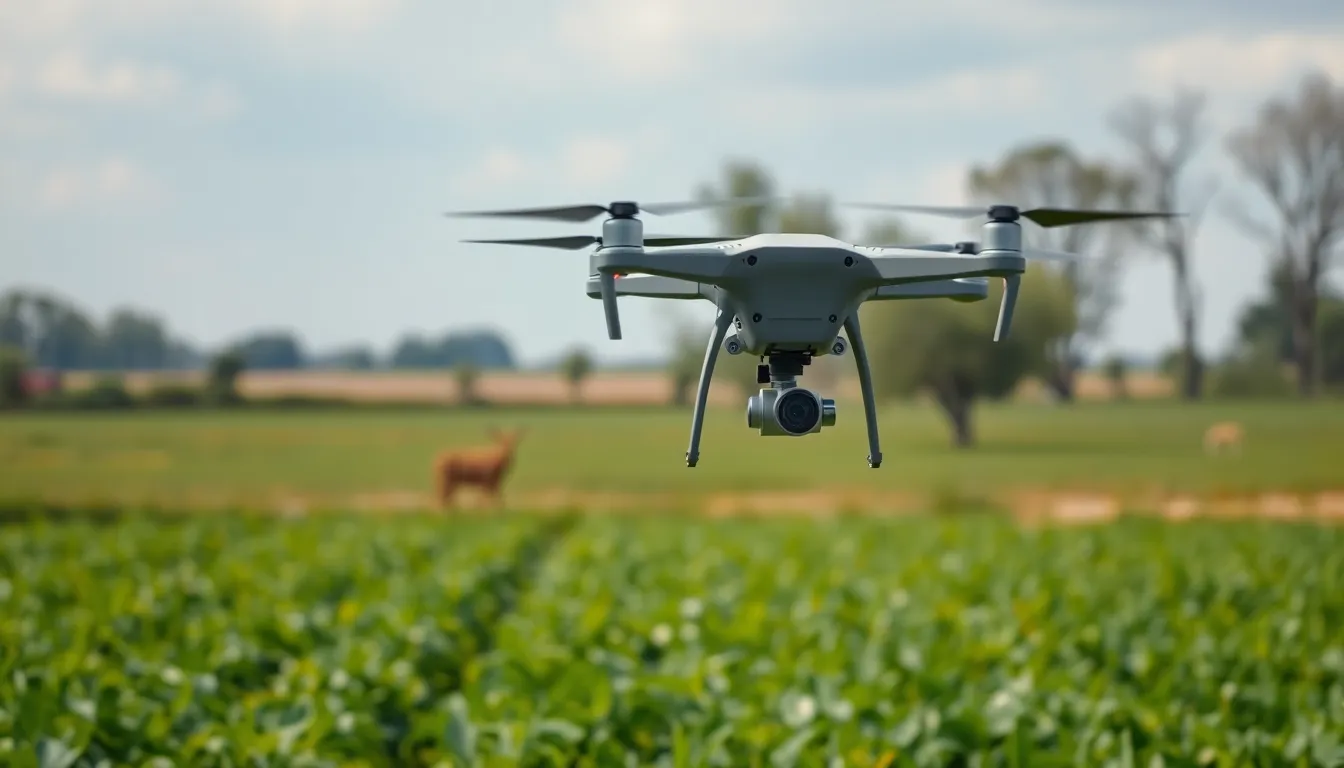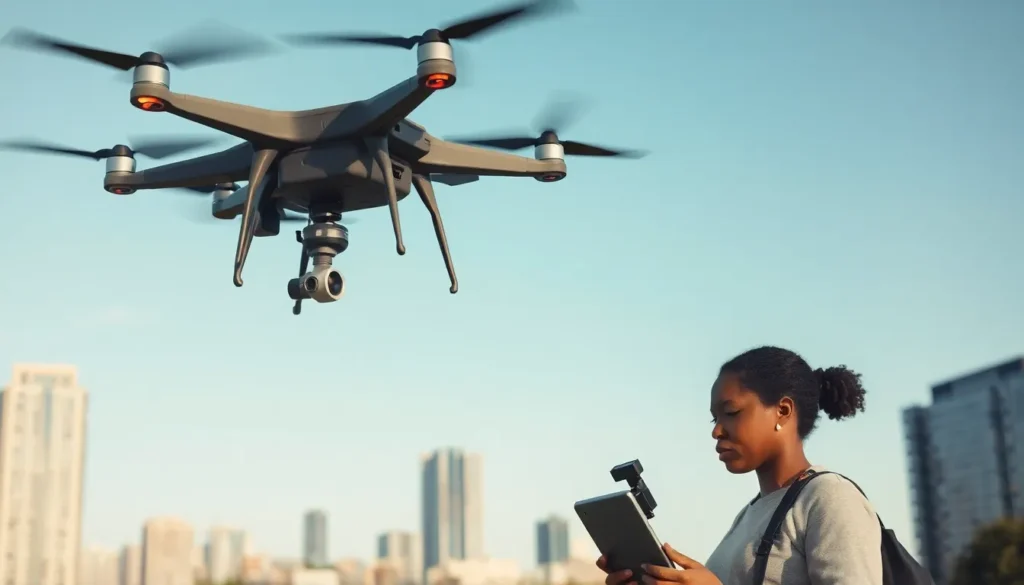In a world where noise pollution is as common as traffic jams, silent drones are making a grand entrance, and they’re not just sneaking up on your picnic. Imagine a drone that glides through the air like a stealthy ninja, capturing stunning aerial footage without disturbing a single bird. These marvels of technology are revolutionizing industries from filmmaking to agriculture, proving that sometimes, less noise means more impact.
Gone are the days of loud buzzing interrupting your peaceful afternoon. Silent drones are here to save the day, blending cutting-edge engineering with whisper-quiet operation. Whether it’s for surveillance, delivery, or simply capturing breathtaking landscapes, these drones are ready to take flight—while you enjoy the serenity below. Buckle up and prepare for a journey into the fascinating world of silent drones, where innovation meets tranquility in the skies.
Table of Contents
ToggleOverview of Silent Drones
Silent drones operate using advanced technology that significantly reduces noise during flight. Their design allows for more discreet functioning compared to traditional drones, making them ideal for sensitive applications such as surveillance. Various industries benefit from these quiet machines, including filmmaking, where sound disruption can ruin crucial scenes. Additionally, agriculture receives advantages through silent drones, enhancing monitoring of crops without alarming wildlife or nearby residents.
Manufacturers employ innovative engineering techniques to minimize vibrations and optimize propeller designs, leading to quieter operations. Companies like DJI and Parrot have introduced models specifically engineered for low noise output. Each model utilizes specific features that contribute to overall silence, ensuring they blend seamlessly into environments.
Research shows silent drones outperform traditional models, especially in urban settings where noise regulations are strict. These quiet drones provide operators with greater flexibility to carry out aerial tasks discreetly. Data reveals that industries that adopt silent drone technology often achieve better outcomes, like increased productivity in delivering goods or surveying land.
Environmental considerations also come into play with silent drones. Minimizing noise pollution proves beneficial in maintaining a serene atmosphere, especially in recreational areas. Silent operation encourages wildlife protection, reducing stress levels among animals during monitoring activities. Overall, the evolution of silent drones marks a significant shift towards quieter, more efficient aerial solutions, ensuring they meet diverse operational needs across various fields.
Benefits of Silent Drones

Silent drones offer numerous advantages that revolutionize various industries. Their quiet operation enhances the overall experience in applications where noise can be disruptive.
Noise Pollution Reduction
Noise pollution significantly decreases with the use of silent drones. These drones operate with advanced technology that minimizes sound during flight. Agriculture benefits greatly, as quiet drones monitor crops without disturbing wildlife. Filmmakers enjoy uninterrupted scenes because sound disruption remains a concern in capturing quality footage. Urban environments also see improvements; strict noise regulations are less challenging with silent drones. Research shows a direct correlation between lower noise levels and increased productivity in tasks such as deliveries. Enhanced sound control often leads to improved workflows across diverse fields.
Enhanced Stealth Operations
Stealth becomes a key advantage of silent drones in surveillance operations. Their quiet design allows for discreet monitoring without alerting targets. Security personnel rely on their unobtrusive capabilities to enhance situational awareness in sensitive areas. Wildlife researchers benefit too; less noise minimizes stress on animals during monitoring. Innovations in design optimize propellers to reduce lift noise, enabling seamless missions. These drones operate effectively in urban settings, giving operators flexibility in navigating populated areas. Therefore, the integration of silent drones in stealth operations often results in better outcomes for various applications.
Applications of Silent Drones
Silent drones find utility in a variety of sectors due to their ability to operate quietly and efficiently. Their application spans military and commercial uses that enhance operational effectiveness without drawing attention.
Military Uses
In military operations, silent drones play a crucial role in reconnaissance and surveillance. Enhanced stealth capabilities allow these drones to gather intelligence without revealing their presence. Units can monitor enemy movements discreetly, providing strategic advantages. Furthermore, minimal noise levels support operations in populated areas, reducing civilian disturbances. Reliable data collection during sensitive missions leads to improved decision-making and operational success. These drones adapt to various terrains, fulfilling diverse military needs, proving essential in modern warfare.
Commercial Uses
Silent drones significantly impact commercial industries, streamlining operations in sectors like filmmaking and agriculture. Filmmakers benefit from noise-free aerial shots, ensuring uninterrupted sound quality in their productions. Agriculture professionals utilize these drones for crop monitoring, effectively managing land without disturbing wildlife. Delivery services also see improvements in customer satisfaction due to less impactful noise pollution, enabling timely and discreet parcel drop-offs. Enhanced efficiency in various tasks leads to increased productivity while maintaining a quiet environment. Overall, the contributions of silent drones redefine operational standards in commercial applications.
Technology Behind Silent Drones
Silent drones leverage advanced technology to minimize noise during operation, catering to the demand for discreet aerial solutions. Key innovations revolve around propulsion systems and design advancements.
Propulsion Systems
Electric propulsion systems power silent drones, focusing on efficiency and reduced noise levels. Brushless motors play a crucial role in delivering quiet operation, enabling seamless flight. Additionally, some models incorporate specific propeller designs that reduce turbulence and further minimize sound. These technologies allow operators to execute tasks effectively, especially in urban environments. As drone enthusiasts recognize the benefits of quieter machines, manufacturers continue to enhance propulsion systems to satisfy market needs.
Design Innovations
Innovative design features contribute significantly to the sound-reducing capabilities of silent drones. Manufacturers prioritize airframe shapes that promote aerodynamic efficiency, decreasing drag and noise generation. Materials also impact noise levels, with lightweight composites often used to dampen vibrations during flight. Such advancements allow filmmakers and agricultural professionals to utilize drones without disturbing their surroundings. Enhanced stability through design adjustments ensures smoother operation, further reducing sound during aerial maneuvers. Each of these elements works together to create a quieter, more functional drone experience.
Future of Silent Drones
Emerging technologies promise further enhancements for silent drones. Innovations in battery life and power management extend flight durations significantly, addressing one of the primary limitations in drone operations. Operators can expect improvements in range, enabling more extensive coverage during missions.
Developers are focusing on artificial intelligence and machine learning integration within silent drones. Such advancements lead to smarter navigation systems, allowing drones to adapt to changing environmental conditions or obstacles without human intervention. Enhanced automated features reduce the need for constant monitoring, boosting overall operational efficiency.
Collaboration among manufacturers strengthens the potential of silent drone technology. Industry leaders are joining forces to share research and develop standards for silent operations. This synergy not only enhances performance but also promotes safety in crowded environments.
In addition, silent drones are likely to play an increasing role in urban planning and smart city initiatives. Their ability to gather precise data quietly opens new avenues for infrastructure monitoring and environmental assessments. Urban developers and local governments benefit from detailed analytics provided by silent drones, facilitating better decision-making.
The market for silent drones is evolving rapidly, fueled by growing demand across multiple sectors. Filmmakers, agriculturalists, and security personnel increasingly recognize their value in diverse applications. As awareness of their benefits spreads, silent drones stand to gain even more traction in commercial use.
Regulatory frameworks will also adapt to accommodate silent drones. Policymakers are beginning to recognize their potential for reducing noise pollution while enabling critical operations. Future regulations may prioritize silent drone use in sensitive areas, further securing their place in the aerial technology landscape.
Silent drones are redefining the landscape of aerial technology. Their ability to operate quietly not only enhances various industries but also promotes environmental sustainability. As these drones continue to evolve with advancements in technology and design, their applications will expand further.
From filmmaking to agriculture and beyond, the advantages of silent operation are clear. They offer a unique blend of efficiency and discretion that traditional drones cannot match. The future looks promising as silent drones become integral to urban planning and smart city initiatives. As awareness of their benefits grows, so will their presence in commercial and military sectors, solidifying their role in reducing noise pollution while delivering critical services.

